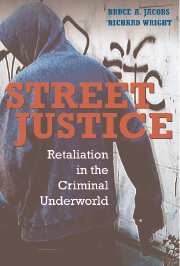Crossref Citations
This Book has been
cited by the following publications. This list is generated based on data provided by Crossref.
Schreck, Christopher J.
Burek, Melissa W.
Stewart, Eric A.
and
Miller, J. Mitchell
2007.
Distress and Violent Victimization among Young Adolescents.
Journal of Research in Crime and Delinquency,
Vol. 44,
Issue. 4,
p.
381.
Libby, Nicholas E.
and
Corzine, Jay
2007.
Lethal Weapons: Effects of Firearm Types on the Outcome of Violent Encounters.
Justice Research and Policy,
Vol. 9,
Issue. 2,
p.
113.
Jacobs, Bruce A.
and
Wright, Richard
2008.
Moralistic Street Robbery.
Crime & Delinquency,
Vol. 54,
Issue. 4,
p.
511.
JACQUES, SCOTT
and
WRIGHT, RICHARD
2008.
THE VICTIMIZATION–TERMINATION LINK*.
Criminology,
Vol. 46,
Issue. 4,
p.
1009.
SCHRECK, CHRISTOPHER J.
STEWART, ERIC A.
and
OSGOOD, D. WAYNE
2008.
A REAPPRAISAL OF THE OVERLAP OF VIOLENT OFFENDERS AND VICTIMS*.
Criminology,
Vol. 46,
Issue. 4,
p.
871.
Rader, Nicole E.
2008.
Gendered Fear Strategies: Intersections of Doing Gender and Fear Management Strategies in Married and Divorced Women's Lives.
Sociological Focus,
Vol. 41,
Issue. 1,
p.
34.
Jacques, Scott
and
Wright, Richard
2008.
Intimacy with Outlaws.
Journal of Research in Crime and Delinquency,
Vol. 45,
Issue. 1,
p.
22.
JACQUES, SCOTT
and
WRIGHT, RICHARD
2008.
THE RELEVANCE OF PEACE TO STUDIES OF DRUG MARKET VIOLENCE*.
Criminology,
Vol. 46,
Issue. 1,
p.
221.
Kruttschnitt, Candace
and
Gartner, Rosemary
2008.
Female Violent Offenders: Moral Panics or More Serious Offenders?.
Australian & New Zealand Journal of Criminology,
Vol. 41,
Issue. 1,
p.
9.
Stewart, Eric A.
Schreck, Christopher J.
and
Brunson, Rod K.
2008.
Lessons of the Street Code.
Journal of Contemporary Criminal Justice,
Vol. 24,
Issue. 2,
p.
137.
KLINGER, DAVID A.
2008.
ON THE IMPORTANCE OF SOUND MEASURES OF FORCEFUL POLICE ACTIONS*.
Criminology & Public Policy,
Vol. 7,
Issue. 4,
p.
605.
Mullins, Christopher W.
and
Miller, Jody
2008.
Temporal, Situational and Interactional Features of Women's Violent Conflicts.
Australian & New Zealand Journal of Criminology,
Vol. 41,
Issue. 1,
p.
36.
MELDE, CHRIS
2009.
LIFESTYLE, RATIONAL CHOICE, AND ADOLESCENT FEAR: A TEST OF A RISK‐ASSESSMENT FRAMEWORK*.
Criminology,
Vol. 47,
Issue. 3,
p.
781.
BREZINA, TIMOTHY
TEKIN, ERDAL
and
TOPALLI, VOLKAN
2009.
“MIGHT NOT BE A TOMORROW”: A MULTIMETHODS APPROACH TO ANTICIPATED EARLY DEATH AND YOUTH CRIME*.
Criminology,
Vol. 47,
Issue. 4,
p.
1091.
Melde, Chris
and
Esbensen, Finn-Aage
2009.
The Victim-Offender Overlap and Fear of In-School Victimization.
Crime & Delinquency,
Vol. 55,
Issue. 4,
p.
499.
Copes, Heith
and
Vieraitis, Lynne M.
2009.
Understanding Identity Theft.
Criminal Justice Review,
Vol. 34,
Issue. 3,
p.
329.
Papachristos, Andrew V.
2009.
Murder by Structure: Dominance Relations and the Social Structure of Gang Homicide.
American Journal of Sociology,
Vol. 115,
Issue. 1,
p.
74.
Ezell, Michael E.
and
Tanner-Smith, Emily E.
2009.
Examining the Role of Lifestyle and Criminal History Variables on the Risk of Homicide Victimization.
Homicide Studies,
Vol. 13,
Issue. 2,
p.
144.
Bellair, Paul E.
and
McNulty, Thomas L.
2009.
Gang Membership, Drug Selling, and Violence in Neighborhood Context.
Justice Quarterly,
Vol. 26,
Issue. 4,
p.
644.
Copes, Heith
and
Vieraitis, Lynne M.
2009.
Bounded rationality of identity thieves: Using offender‐based research to inform policy*.
Criminology & Public Policy,
Vol. 8,
Issue. 2,
p.
237.



